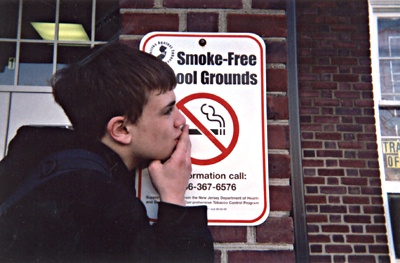All Nonfiction
- Bullying
- Books
- Academic
- Author Interviews
- Celebrity interviews
- College Articles
- College Essays
- Educator of the Year
- Heroes
- Interviews
- Memoir
- Personal Experience
- Sports
- Travel & Culture
All Opinions
- Bullying
- Current Events / Politics
- Discrimination
- Drugs / Alcohol / Smoking
- Entertainment / Celebrities
- Environment
- Love / Relationships
- Movies / Music / TV
- Pop Culture / Trends
- School / College
- Social Issues / Civics
- Spirituality / Religion
- Sports / Hobbies
All Hot Topics
- Bullying
- Community Service
- Environment
- Health
- Letters to the Editor
- Pride & Prejudice
- What Matters
- Back
Summer Guide
- Program Links
- Program Reviews
- Back
College Guide
- College Links
- College Reviews
- College Essays
- College Articles
- Back
Subliminal Advertisements MAG
Are cigarette ads really absent from TV? I'd liketo think so, but maybe they are just taking a different form.
For twoyears I have been a proud member of Stand, an organization of Ohio teens whospeak out against tobacco. As a member, I have learned a lot about the harmfuleffects of tobacco use, and how much of its advertising is directed towardchildren and teens.
The information from my health class and Stand hasled me to realize that even though Congress banned tobacco ads from TV and radioin 1970, we are still exposed to "ads." In 2003, one of the world'sleading medical journals published a study that says "Smoking in movies isresponsible for addicting 1,070 American adolescents to tobacco every day, 340 ofwhom will die prematurely as a result" (The Lancet). This addictive habit isa result of subliminal ads. Kids and teens see their favorite stars smoke and, ofcourse, think it is cool.
Some examples can be found in "King of theHill" and "The Simpsons," as well as in movies like "Gangs ofNew York" (awarded a Black Lung by professional movie reviewers who ratemovies on the amount of tobacco use). These subliminal ads are also directed tochildren's shows and movies; about two-thirds of children's animated filmsinclude some form of tobacco and alcohol use.
Now, if you analyze thesesubliminal ads, you can see who plays what role. For example, your favorite starsand characters who do the smoking are the spokespeople who make smoking look"cool." As you might have noticed, I haven't mentioned how thecompanies get their names into these ads because usually they don't. Rather, theyconcentrate on getting the idea of how cool smoking is into our youth's minds.
I bet that you have no idea that the rate of tobacco use in PG-13 moviesincreased to 82% in 2003, and that in R-rated movies the use has gone up to morethan 76%. One reason for the increase is because the tobacco companies aretargeting adolescents as a way to replace deceased smokers, and create youngaddicts. You might also want to be careful how much music TV you watch - MTV,BET, CMT and VH1 - since it is a fact that teens who watch five hours or more ofthese shows are 18% more likely to start smoking. Plus, if you grew up in anon-smoking household, you are affected more than those who grew up with a parentwho smokes.
Now that the horrible truth about the over-glamorization oftobacco use has been brought to your attention, I would like to ask you to helpput an end to this subliminal brainwashing. Join the fight and help getglamorized tobacco use out of the movies and television shows directed toward theyouth of America, so they don't become the smokers oftomorrow.
Unless otherwise noted, facts in this article can befound at standonline.org

Similar Articles
JOIN THE DISCUSSION
This article has 1 comment.

0 articles 0 photos 12292 comments